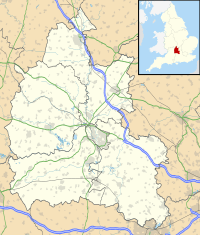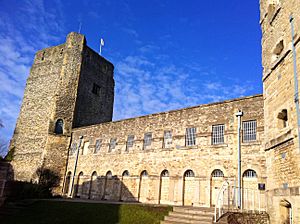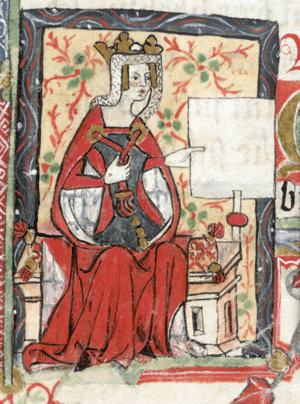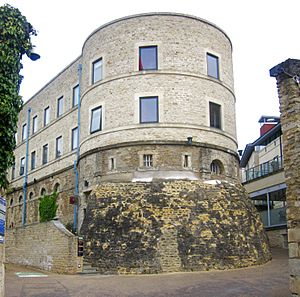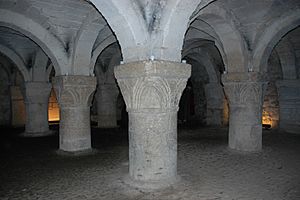Oxford Castle facts for kids
Quick facts for kids Oxford Castle |
|
|---|---|
| Oxfordshire, England | |
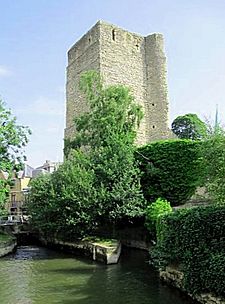
St George's Tower, Oxford Castle, viewed from the Castle Mill Stream
|
|
| Coordinates | 51°45′06″N 1°15′48″W / 51.7517°N 1.2632°W |
| Grid reference | grid reference SP509063 |
| Type | Shell keep and bailey |
| Site information | |
| Owner | Oxfordshire County Council |
| Condition | Ruined, elements used as a hotel |
| Site history | |
| Materials | Coral rag and gravel |
Oxford Castle is an old, partly ruined medieval castle in Oxford, England. It sits on the western side of the city center. Most of the original wooden castle was rebuilt with stone in the late 1100s or early 1200s. This castle was very important during a civil war known as the Anarchy.
Later, in the 1300s, the castle wasn't needed for fighting anymore. It became a place for local government and a prison. The tall, rectangular St George's Tower is thought to be even older than the rest of the castle. It might have been a watchtower for the city's old Saxon west gate.
Much of the castle was destroyed during the English Civil War. By the 1700s, the remaining buildings were used as Oxford's main prison. A new prison complex was built there starting in 1785 and grew larger in 1876. This became known as HM Prison Oxford.
The prison closed in 1996. After that, it was turned into a hotel and a place for visitors to explore. The old parts of the castle, like the big mound (motte), St George's Tower, and the crypt, are now protected historic buildings.
Contents
Building Oxford Castle
Oxford Castle was built by a Norman lord named Robert D'Oyly the elder. He started building it between 1071 and 1073. Robert D'Oyly came to England with William the Conqueror in 1066. William gave him a lot of land in Oxfordshire.
Oxford had been damaged during the invasion. So, William told D'Oyly to build a castle to control the town. D'Oyly became the most important landowner in Oxfordshire. He was also given the job of royal constable for Oxford Castle.
D'Oyly built his castle on the west side of Oxford. He used a natural stream from the River Thames for protection. This stream, now called Castle Mill Stream, was also used to create a moat around the castle.
Historians have wondered if there was an older English fort on the site. While there's evidence of Anglo-Saxon homes, there's no clear proof of an earlier fort. Oxford Castle was built over part of the old Saxon town wall.
The first castle was probably a large motte and bailey design. This means it had a big earth mound (motte) with a tower on top. It also had a walled courtyard (bailey) below. The motte was originally about 60 feet (18 meters) high and 40 feet (12 meters) wide.
By the late 1100s or early 1200s, the wooden walls and tower were replaced with stone. The new stone wall included St George's Tower. This tower is made of a type of stone called coral rag. It is 30 by 30 feet (9 by 9 meters) at the bottom and gets narrower at the top.
This was the tallest tower in the castle. Many now believe it was built in Saxon times, around 1020. It might have been a watchtower for the Saxon city's west gate. Its direction is different from the rest of the castle. Its height would have given a great view over the city before the castle mound was built.
Inside the castle walls, there was a chapel with a crypt attached to St George's Tower. A crypt is an underground room, often used for burials. This chapel might have been built on the site of an older church. It had a typical early Norman design with strong pillars and arches.
The chapel was dedicated to Saint George. The crypt of this chapel still exists today. It was moved and rebuilt using its original stones in 1794.
The castle also had a ten-sided stone tower called a shell keep. It was 58 feet (17.6 meters) across. This was built in the 1200s to replace an earlier wooden one. Inside the keep, stairs led 20 feet (6 meters) down to an underground stone room. This room had a well that was 54 feet (16.4 meters) deep. This well provided water during a siege.
Castle's Role in Wars
Robert D'Oyly the younger, the nephew of the castle's founder, owned the castle during the Anarchy. This was a civil war in the 1140s. Robert first supported King Stephen, but then he switched to support Empress Matilda. Matilda was Stephen's cousin and wanted to be queen.
In 1141, Empress Matilda came to Oxford to use the castle as her base. King Stephen then marched from Bristol in late 1142. He attacked and took over Oxford town, then surrounded Matilda in the castle. Stephen set up two large mounds next to the castle. He placed siege machines on them, mostly to scare people. He then waited for Matilda's supplies to run out over the next three months.
Finally, in December, Matilda escaped from the castle. A popular story says she waited until the Castle Mill Stream froze over. She then dressed in white to blend in with the snow. She was lowered down the walls with a few knights and escaped through Stephen's lines at night. Another historian, William of Malmesbury, said she escaped from one of the gates. Matilda reached Abingdon-on-Thames safely. Oxford Castle surrendered to Stephen the next day.
In the First Barons' War (1215–1217), the castle was attacked again. This led to more improvements in its defenses. In 1220, a powerful lord named Falkes de Breauté built a moated barbican to protect the main gate even more. A barbican is a fortified gatehouse.
King Henry III turned part of the castle into a prison. It was used to hold university students who caused trouble. He also improved the castle chapel. He added stained glass windows in 1243 and 1246. However, the castle never became a royal home because there was another royal palace nearby.
Later Years and Prison Life
By 1327, the castle's defenses were in bad shape. It was estimated that £800 was needed for repairs. From the 1350s onwards, the castle was not used much for military purposes. It slowly fell apart.
The castle became the main center for Oxford county government. It was also a jail and a court for criminals. Court sessions were held there until 1577. That year, a terrible plague broke out, known as the "Black Assize". Many people died, including important local officials. After this, court sessions were no longer held at the castle.
Maps from the 1500s and 1600s show that parts of the castle were being removed. The barbican was taken down to make way for houses. By 1600, the moat was almost completely filled in. Houses were built around the old castle walls.
In 1611, King James I sold Oxford Castle. It was then sold to Christ Church, a college at the university, in 1613. The college then leased it to local families. By this time, the castle was weak, with a large crack in its main tower.
In 1642, the First English Civil War began. The King's supporters, called Cavaliers, made Oxford their capital. In 1646, the Parliament's forces successfully surrounded and took Oxford. Colonel Richard Ingoldsby took control of the city.
Ingoldsby improved the castle's defenses. He tore down most of the old medieval stone walls. He replaced them with modern earth defenses. He also strengthened the main tower to hold cannons. In 1652, during the third English Civil War, the Parliament's soldiers pulled down these defenses too. They moved to New College instead, causing damage there. The castle saw no more fighting. In the early 1700s, the main tower was taken down. The top of the mound was shaped into what it looks like today.
Oxford Castle as a Prison
After the Civil War, Oxford Castle was mainly used as the local prison. Like other prisons then, the owners leased it to wardens. These wardens made money by charging prisoners for food and lodging. The prison also had a gallows for executions.
For most of the 1700s, the prison was run by local families. It was falling apart more and more. A prison reformer named John Howard visited the castle several times in the 1770s. He criticized its small size and poor condition. He also noted how many pests were in the prison. Because of his criticism, the county decided to rebuild the prison.
In 1785, the county bought the castle. Rebuilding began under architect William Blackburn. The wider castle area was already changing. A new road was built through the courtyard. The last parts of the castle moat were filled in to allow a new canal to be built.
Building the new prison involved tearing down the old chapel next to St George's Tower. Part of the crypt was moved in 1794. The work was finished in 1805. The new governor, Daniel Harris, used prisoners to help with early archaeological digs at the castle.
In the 1800s, the site continued to be developed. New buildings like the County Hall (1840–1841) and the Oxfordshire Militia Armoury (1854) were added. The prison itself was made larger in 1876. It grew to take up most of the remaining space. In 1888, national prison changes led to it being renamed HM Prison Oxford.
Oxford Castle Today
Today, the remains of the Saxon St. George's Tower, the Motte-and-Bailey Mound, and parts of the old prison make up the Oxford Castle & Prison tourist attraction.
The prison closed in 1996. The site then went back to Oxfordshire County Council. The old prison buildings have been turned into a restaurant and heritage complex. Visitors can take guided tours of the historic buildings. There are also open courtyards for markets and plays. Part of the former prison is now a hotel called Malmaison Oxford. The old cells have been turned into guest rooms.
The full size of the original castle is hard to see today. This is because newer buildings, like the County Hall, have been built on the eastern side. A road now runs over where part of the old castle wall used to be. However, the path of the old moat is still marked by some streets. The remains of the original barbican are under the modern Westgate shopping center.
Since 1954, the two oldest parts of the castle have been protected as Grade I listed buildings. These include the 11th-century mound with its 13th-century well-chamber. Also protected are the 11th-century St George's Tower (now believed to be Saxon) and the moved crypt chapel. The 18th-century prison D-wing and Debtors' Tower are also protected. The entire site is a Scheduled Monument.
As of 2025, visitors can take guided tours of the remaining medieval and 18th-century parts of the castle. These tours are offered by a company called Heritage Projects (Oxford Castle) Ltd.
See also
 In Spanish: Castillo de Oxford para niños
In Spanish: Castillo de Oxford para niños
- Museum of Oxford
- Castles in Great Britain and Ireland
- List of castles in England


